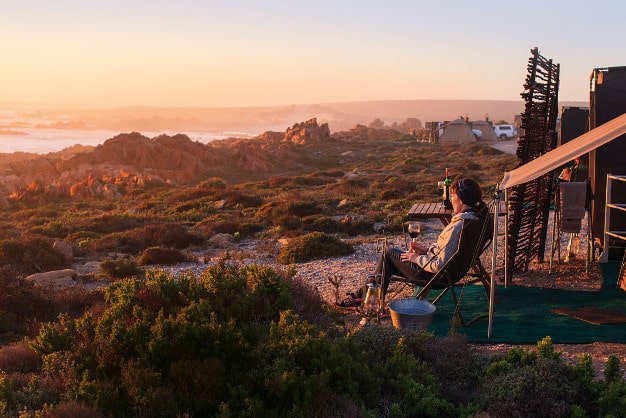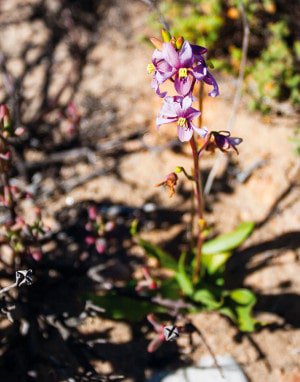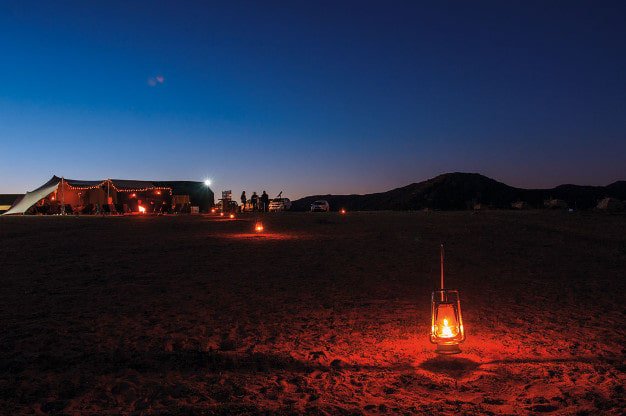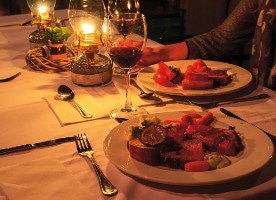Camp Daisy
Article from Wild Life magazine Winter 2018
Like the flowers in Namaqua National Park, luxury safari tents pop up during spring to charm and delight, before disappearing for another year. By Magriet Kruger
I was meant to be in Namaqualand for the daisies, the masses of annuals that carpet the dry west of South Africa following the winter rains. It’s a natural spectacle known for its abundance as seemingly every pocket of the earth is covered in wildflowers. So why was I hunched over a single plant, beaming as if I’d struck a diamond?
“Well spotted,” said Carina Becker, flower guide at Namaqua Flowers Beach Camp as she came closer to look at the slender plant with its dainty petals in pale pink. “That’s a geophyte, a bulb. It’s called Cyanella orchidiformis and doesn’t the flower look like an orchid?
“Notice a couple of big leaves at the bottom of the stem, flat on the soil. That’s the first step for a bulb. It’s a way to keep the roots cool and trap moisture under the leaves.” To cope with the harsh environment of salty air, strong winds and little rain, the plant was using every strategy available to it. In its determination and fragile beauty, the lone bulb was every bit as impressive as any field of flowers.
Like a painting that needs to be seen up close to appreciate the mastery, I was discovering that the Namaqua flowers reveal so much more when you get out of the car. And fortunately, I was staying in the right place to do so.
A Stand Among the Vygies
Situated near Springbok, 495km up the West Coast from Cape Town, Namaqua National Park is the destination for flower season. This part of South Africa is home to the richest bulb flora of any arid region in the world, and it’s estimated that more than 1,500 of its 3,500 plant species are found nowhere else.
The Skilpad Wildflower Reserve near Kamieskroon is the heart of the national park. Here granite outcrops form textured backdrops for an astonishing diversity of plants, from colourful daisies to curiously shaped succulents. Along the coast, the park stretches between the Groen and Spoeg rivers, an area known for its neon-bright vygies.
In August and September, people come from all over the world for the flower display, but until relatively recently accommodation options were limited. The park’s four cottages at Skilpad are fully booked almost a year in advance and the rustic campsites by the coast are strictly for self-sufficient campers.
So in 2011, Allan Johnston and Lysta Stander of Chiefs Mobile Safaris came up with the idea to pitch luxury tents at one of Namaqua National Park’s coastal campsites. For a month only, Namaqua Flowers Beach Camp goes up at the Delwerskamp site. Since 2015, a mobile camp also arises at Skilpad. “It’s a wonderful joint initiative with SANParks,” said Allan, “and the only place to sleep in the flowers.”
Luxury Defined
Comprising 15 guest tents, Namaqua Flowers Beach Camp exudes luxury and exclusivity. In the tented lounge oriental rugs and designer lamps create a cosy atmosphere for paging through coffee table books. In the mess tent next door, chefs serve three-course meals and freshly baked pastries.
The safari tents offer a luxurious take on camping with proper beds, electric blankets and hot water showers. I installed myself in one of the easy chairs in front of the tent to watch the sea break in lacy waves metres away.
“What’s the definition of luxury?” asked Allan as we chatted later in the Daisy Lounge. “It’s not just what’s in the tent that’s special, the privilege lies in the setting. It’s the sound of the sea at night. It’s stepping out of your tent and being amid the flowers. We’ve had whales 100m offshore every second day. Guests can take a picnic and drive up the coast and not see another person.”
After dinner, I mulled the activities for the next day. We’d had a fine meal of roasted tomato soup, followed by beef stroganoff, and were lingering over chocolate brownies. There was the option of driving up the coast to the seal colony or the Spoegrivier Caves, where archaeologists had found evidence of sheep farming some 2000 years ago. But I was in the grips of flower fever, so I signed up for the guided walk.
Flowers on Foot
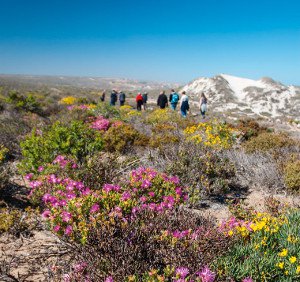
Mind your step: Exploring on foot allows you to get close to the flowers but you have to watch where you put your feet.
The rendezvous time for the flower walk was at ten, leaving ample time for an indulgent breakfast. An hour into the walk our group was still within sight of camp. There was so much to see and Carina, a doctoral student in ecology at UCT, had fascinating insights to share every step of the way.
“Take a look at the Cape rain daisy with its white petals. Did you notice that they are purple on the outside? When the dark colour is warmed by the sun, the flower knows to open up. Plants in Namaqualand have to be energy efficient, so these daisies only open in good conditions when insects are about.”
Carina pointed out the so-called ice plants, Mesembryanthemum sp., which store water in tiny cells that sparkle in the light. I stuck my nose close to Bokbaai vygies to breathe in their honey-like scent and admired the black dots at the bottom of each petal in a Namaqua daisy, meant to mimic beetles and thereby attract the real pollinator. We learnt to identify a female toktokkie by the red stripes on its behind and on a path leading down to the beach we even came across otter tracks.
As we ambled sociably, scanning the veld for birds and keeping an eye out for spoor, I realised Namaqua National Park is not just about the daisies. It’s about immersing yourself at the moment. It’s falling asleep to the roar of the waves. It’s finding beauty in a single bloom. It’s taking time out to appreciate life’s true luxuries.
Trip Planner
Getting there Namaqua National Park is a six-hour drive north from Cape Town.
Conservation fees R40 an adult, R20 a child, Wild Card members free
Rates Namaqua Flower Beach and Skilpad Camp R2,250 a person sharing a night, including breakfast, high tea and a three-course dinner. The mobile camps are set up from 23 August to 23 September only. Visit www.flowercamps.co.za or call 084 299 5777.
SANParks has four chalets at Skilpad, R1,120 for one or two people a night during flower season, R263 an extra adult, R132 an extra child. Coastal campsites R147 for one to six people, no powerpoints and enviro-toilets only.
Contact SANParks Central Reservations 012-428-9111
Easy, breezy Skilpad
If the beach camp is salty air, the whoosh of the ocean and splotches of bright colour, Namaqua Flowers Skilpad Camp is altogether more earthy. Here the view takes in rolling hills leading up to the Kamiesberge and the hum of insects make up the soundtrack. Launched in 2015, the camp offers many of the same luxuries as its sibling by the sea, but it is easily reached by sedan off the N7 and even has mobile connectivity.
After good rains, the pop-up camp’s 15 guest tents seem to rise straight from the daisies. I experienced Skilpad after the worst drought in 70 years but even so had to step carefully to avoid trampling any flowers. Two easy day walks, both starting from close to park reception, take you deep into this wildflower garden. I took the Skilpad Hiking Trail and came across remarkably tolerant gemsbok grazing among the daisies.
Book your accommodation right here on ShowMe.
You can find the top hotels, lodges and Airbnb establishments conveniently placed on the map below. All you need to do is click on the place that’s conveniently located and within your budget and then make a booking. What could be easier?
If the map is not where you want to be, click on the ShowMe Pin and then enter the exact name of the location and the map will adjust accordingly.



